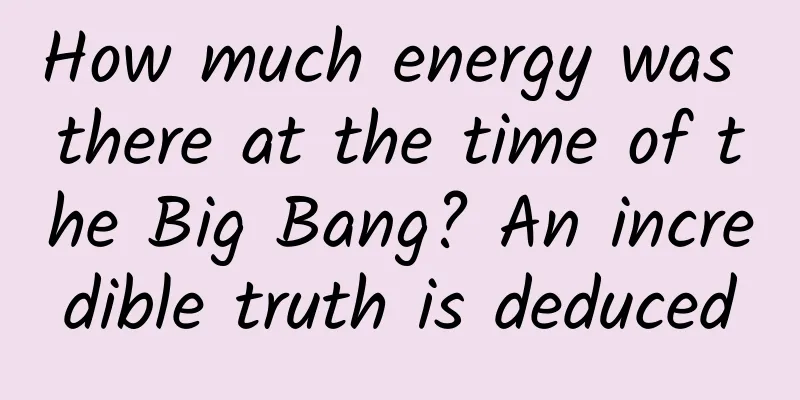How much energy was there at the time of the Big Bang? An incredible truth is deduced

|
A friend invited me to answer this question: The temperature of the universe at 10^-43s after the Big Bang was 10^32K, how many ev is that in terms of energy? This question seems very sophisticated, but it contains a mistake: energy has nothing to do with temperature, but only with mass, following Einstein's mass-energy equation. The unit of energy is joule, symbolized by J; ev is the symbol for electron volt, and there is a conversion relationship with the energy unit joule, 1J=6.2415*10^18eV. In the process of solving this problem, I made a guess about the mass of the universe based on the Big Bang cosmological model, and I got an incredible result, which completely overturned my cognition. I have always firmly believed in the data deduced from the Big Bang cosmological theory, but now I am confused. The standard model's description of the Big Bang at the Planck time/The standard model of the Big Bang universe currently recognized by the scientific community believes that the universe was born about 13.8 billion years ago from the explosion of a singularity with infinitely small volume, infinite density, infinite curvature, and infinitely high temperature. Since the volume of this singularity is infinitely small, its temperature and density cannot be calculated, which leads to the four infinities. According to the quantum theory of modern physics, human beings can only understand the universe from the Planck time. The standard model of the universe believes that at the Planck time of the Big Bang, the size of the universe was the Planck scale, the temperature at that time was the Planck temperature, and the density was also the Planck density. With these data, we can roughly calculate the mass of the universe. The Planck time of the Big Bang refers to about 10^-43 seconds after the Big Bang, which is one trillionth of a trillionth of a second; the temperature of the universe reaches 10^32 degrees K, which is about 100 trillion trillion K; the density of the universe at this time may exceed 10^91 kilograms per cubic centimeter. The model gives us these sets of data. It is impossible to calculate the mass of the universe based on these data, as time and temperature have nothing to do with mass. However, if the volume of the universe at this time is the Planck scale, we can calculate the volume of the universe, and thus the mass of the universe. The mass and energy of the universe at Planck time/According to the theory created by Max Planck, the founder of quantum mechanics, the Planck length is about 1.6*10^-33 cm. If the universe at Planck time is a sphere with a Planck length diameter, according to the sphere volume formula V=(4/3)*π*R^3 (V: represents the volume of the sphere, R: represents the radius of the sphere), we can calculate that the volume of the universe at this time is about 2.145^-99 cubic centimeters. The standard cosmological model tells us that the density of the Planck time universe is about 10^91 kilograms per cubic centimeter. This density is 78 orders of magnitude higher than the density of a proton, which seems to be an unimaginable and amazing density. But the problem is that the universe is extremely small at this time, and it is amazingly small, only 2.145^99 of 1 cubic centimeter, which is 2145 billion ... If we calculate based on 10^91 kilograms per cubic centimeter, such a small universe is only about 2.145*10^-8 kilograms, or 0.00000002145 kilograms, or 21.45 micrograms. According to Einstein's mass-energy conversion formula E=MC^2, the equivalent energy is 1930500000J, and 1 joule is approximately equal to 6.25*10^18eV. Therefore, the energy of the universe at Planck time is about 1.2*10^28eV. How big is this energy? If calculated according to the explosives, it is only equivalent to the explosive power of 461 kg of TNT. I was very surprised because I had never calculated how much energy there was during the Big Bang. I simply thought that the density of 10^91 kg/cm3 was an unimaginable density, so the explosion energy was extremely large. But I didn't think about it carefully. This is the density of the universe when it reaches 1 cubic centimeter, and the Big Bang Planck time scale is only 1.145*10^-99 cubic centimeters. If the density at this time is 10^91 kilograms per cubic centimeter, then the mass of such a small universe is only 21.45 micrograms. The question of the origin of mass is derived from this. What is going on? According to the brief history of the Big Bang, there is only such a mass at Planck time. If the result is derived from the standard model theory, is it that I calculated it wrong, or is there something wrong with the derivation of this theory itself? Because the mass of the universe is a very huge value, the mass of the solar system is about 2*10^30 kilograms, and the mass of the Milky Way is about 200 billion times that of the sun, which is about 4*10^41 kilograms; some people believe that the observable universe has reached 10^53 kilograms. This is only the mass of visible matter, including stars, galaxies, nebula dust, etc. Research suggests that visible matter in the universe only accounts for 4.9% of the total mass-energy of the universe, while the remaining 26.8% is invisible dark matter and 68.3% is invisible dark energy. If both dark matter and dark energy are added together, the total mass-energy of the observable universe can reach 2*10^54 kilograms. Why is there such a huge difference between the mass at the beginning of the Big Bang and the mass now? Where did this extra mass come from? There are only two explanations: one is that the data calculated by the Big Bang theory model is wrong; the other is that mass is automatically generated as the Big Bang expands. But this seems to contradict the law of conservation of mass and mass-energy. Is it the fault of the universe, the universe model, or my own reasoning? Quantum mechanics theory holds that before the birth of the universe, the empty vacuum was filled with quantum energy, and virtual particle pairs were constantly generated in random quantum fluctuations. These positive and negative particle pairs were generated and annihilated at any time. In general, the universe is symmetric and conserved, but if everything is always perfectly symmetrical and conserved, our world would not have been born. The law of parity non-conservation discovered by Chen Ning Yang and Tsung-Dao Lee has helped the scientific community uncover the mystery of the birth of the universe. It is the symmetry breaking in conservation that causes the annihilated virtual particle pairs to have a certain non-annihilation phenomenon, thus the cosmic singularity appears. The Big Bang theory holds that the universe was created from nothing, and mass naturally came from nothing as well. Particle physicists have established a particle theory model that provides a framework for us to understand the fundamental particles in the universe. This framework is the so-called standard model, one of the main components of which is the Higgs field. This ubiquitous quantum field contains a fundamental particle, the so-called Higgs boson, also known as the God particle. It is this particle that gives other particles mass, creating the world just like the God in mythology created everything. The particle theory model is no longer a conjecture, and all predicted particles have basically been obtained in experiments. The God particle was also found in the world's largest hadron collider in 2012. So, can the above theory explain the mystery of the difference between the mass of the Big Bang Planck time and the mass of the current universe? Welcome to discuss, thank you for reading. This work is the original copyright of Space-Time Communication. Please do not infringe or plagiarize. |
<<: 【Creative Cultivation Program】Rutherford: What's inside the nucleus? Open it and see
Recommend
How to use Baidu's active push? How to use cygwin active push correctly?
How to use Baidu's active push? How to use cy...
How to create a hit marketing plan?
In 2019, we saw all kinds of people spreading kno...
Layoffs for the winter, will you be one of the 20% who are laid off at the end of the year?
[[153798]] Within 48 hours, Alibaba reduced its c...
Regarding event creativity, you need to know these 4 key points
As an operator , perhaps you are occupied by vari...
Suborbital manned flight has sparked heated discussion. Astrophysicists have given an in-depth interpretation. How much do you know?
What is suborbital flight? (And why should we car...
TV boxes face collective "rectification", and Internet TV's free lunch is gone
Source: Beijing Daily Original title: TV boxes ar...
Xiaomi valuation topic: Please learn how to do public relations from Lei Jun
Generally speaking, companies that hype valuation...
Teach you how to make money with Douyin from scratch - techniques to attract fans and monetize
Tik Tok - the second wave of short video populari...
How to solve the problem of too many users connected to the Win server terminal?
The test succeeded under 2003 and failed under 20...
iOS 13.6 beta test version released: You can manually turn off iOS automatic updates
Apple today released the second beta of iOS 13.6 ...
"As long as I don't have a physical examination, I'm not sick"
Speaking of physical examination, The reaction of...
Guangdiantong advertising details + optimization techniques
Today, we have specially compiled this article fo...
The fastest way to get started with ReactiveCocoa: Advanced Edition
[[152667]] Preface Due to time constraints, I hav...
Why does your appearance improve so quickly after you put on sunglasses?
Follow "Body Code Decoding Bureau" (pub...
2020, top ten marketing keywords!
Affected by the overall environment this year, al...









